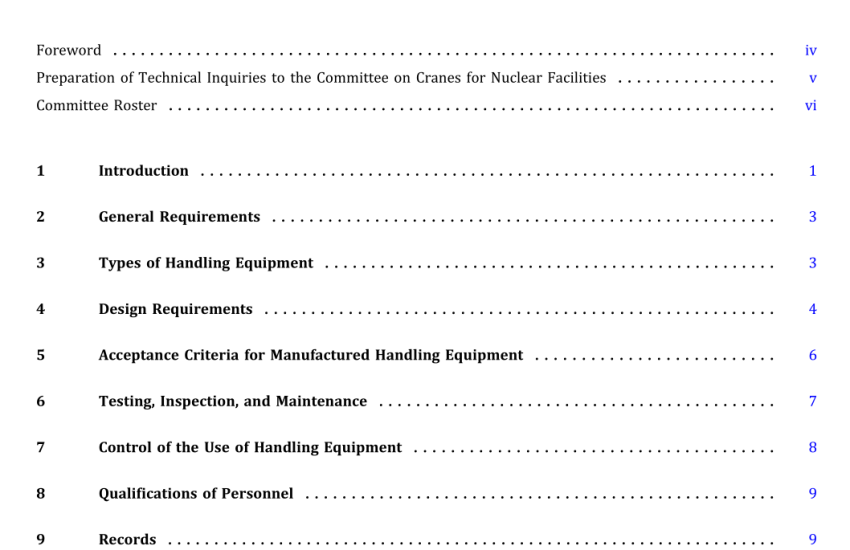ASME HRT-1:2016 pdf download Rules for Hoisting, Rigging, and Transporting Equipment for Nuclear Facilities
2 GENERAL REQUIREMENTS Use of permanent facility handling equipment for construction load handlingis permitted onlyifauthorized bythefacilityownerandconductedinaccordancewiththe owner’s requirements. Ifload-handlingequipmentis used during construction, when temporary use is completed, conditions of temporary use shall be evaluated to verify that the load-handling equipment continues to satisfy the specified requirements for its permanent intended use; the evaluation shall include an estimate of the number of load cycles. After construction use and priorto release forpermanentoperations, the perma- nent facility handling equipment shall be restored to its design configuration, and the facility handling equipment used forconstructionload handlingshall be inspectedand tested as specified in a procedure. The total load cycles used during construction shall be included in the fatigue evaluations for the permanent facility handling equipment. The provisions of this Standard may be used for other than construction activities, including modifications and construction activities at operating facilities, when speci- fied in contract documents. Where this Standard references the use of consensus standards, they shall include the applicable requirements of the ASME B30 safety standards; ASME BTH-1, ASME NOG-1, and ASME NUM-1, or CMAA 70 and CMAA 74; and ANSI/ASSE A10.5.
2.1 Planning and Procedures Planning, procedures, and instructions shall contain details such as weights, sling locations, center of gravity, ground (or floor) and support loading, methods ofattachment, operating speeds, environmental conditions, and other pertinent features to be considered as necessary for safe handling. Planning shall provide for compliance with applicable federal, state, and local regulations. 2.2 Classification of Items Handled The requirements for activities are based on classifying the items into three categories according to their impor- tant physical characteristics. It is recognized that within the scope of each category there may be a range of controls, and that the need for, and extent of, detailed handling requirements for an item is dependent on the importance of the item to safe, reliable operation of the facility and the complexity of the operation. Pertinent manufacturer’s requirements shall be consid- ered when classifying the items. Items for which handling activities are covered by this Standard shall be classified into one of the three categories described in paras. 2.2.1 through 2.2.3. An item shall not be reclassified to a lower status without approval by the responsible organization that assigned the original category.
2.2.1 Category A. Items classified in Category A are those that require specially selected equipment [not necessarily limited to special designed equipment (see para. 3.3)] and detailed procedures for handling opera- tions because of large size and weight or potential for damage or safety hazard if mishandled. Items that may be assigned to this category include the following:
(a) reactor vessels
(b) steam generators
(c) major components of reactor vessel internals
(d) primary system pressurizers
(e) spent fuel casks
(f) subassemblies requiring specially selected equipment
(g) lifts over safety-related structures, systems, and components
(h) major turbine generator components
2.2.2 Category B. Items classified in Category B are those that shall be handled with conventional handling equipment but that require detailed procedures because of susceptibility to damage. Items that may be assigned to this category include the following:
(a) reactor vessel head
(b) primary and intermediate coolantpumps and their internals
(c) designated instrumentcabinets and control boards
(d) control rod drive mechanisms
(e) helium circulators
(f) fuel-handling equipment
(g) purification equipment
(h) fuel (i) core components (small)
2.2.3 Category C. Items classified in Category C are thosethatmaybesafelyhandledwithconventionalequip- ment using good rigging and handling practices as described in safety handbooks, consensus standards, and corporate or contractor standards designated for the job, and in compliance with regulations.
3 TYPES OF HANDLING EQUIPMENT Equipmentcoveredbythis Standardcanbedividedinto four general types, as defined in paras. 3.1 through 3.4. 3.1 Standard Manufactured Components A standard manufactured component is normally a catalog item available from several sources. This equip- ment is generally kept in stock and may be used as a
